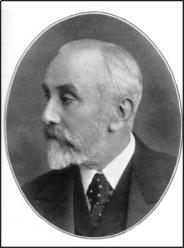- MATTHEWS
- UNITED KINGDOM (see also List of Individuals)\
 8.3.1844 Penzance/UK - 8.1.1922 Hampstead/UK\William Matthews entered at a young age the makers of heavy pumping and mining machinery. In 1864, he was in charge of the wet dock in the tidal harbor of St. Ives. He was offered an engineering position in London with Sir John Coode, of which he became a partner in 1892. In the 1860s Matthews was in charge of the Port Erin breakwater works; in the 1870s, he carried out extensive harbor, river and drainage works in Worthing, Douglas and Thornby. At the age of only 32 years, Matthew was admitted Member of the Institution of Civil Engineers.\It has been said that monuments to Matthews' skill existed in ports and harbors throughout the world. Coode was well known in connection with these works at home and abroad. During the latter's absences Matthews had unusual opportunities of obtaining wide and varied experience in his profession. Later, Matthews himself made journeys to Ceylon, Hong Kong, Singapore, the Cape, Cyprus and Gibraltar where important works were carried out. The firm Coode, Son and Matthews was a consultant for harbors and docks to the Crown Agents for the British Colonies; the firm was also called in by the Admiralty for advice concerning works connected with naval bases, such as for the Keyham Dockyard and the breakwaters of Malta. The outstanding work for the Admiralty was the naval harbor of Dover, which was commenced in 1896 and completed in 1909. On an area of almost 700 acres a harbor for both naval and commercial purposes was erected with the 600 m long Admiralty Pier. Another vast maritime work in which Matthews was particularly involved was Colombo Harbor, in today's Sri Lanka. Matthews was an expert in the construction of breakwaters destined to withstand heavy seas, and he reduced to a fine art the building of such structures by the aid of concrete blocks of large dimensions. In Dover for example, waves of a height up to 6 m were expected whereas in other places, these could be as high as 12 m. Matthews was the president of the Institution of Civil Engineers in 1907; he was made a CMG in 1901 and promoted in 1906 to the Knight Commandership. He was also an Officer of the Belgium Order of Leopold.\Anonymous (1922). Sir William Matthews. The Engineer 133: 47-48. PAnonymous (1922). The late Sir William Matthews, KCMG. Engineering 113: 37-38. P Anonymous (1922). Sir William Matthews. Minutes Institution of Civil Engineers 213: 418-421. Matthews, W. (1908). Presidential address. Minutes Institution of Civil Engineers 171: 5-48. P Pike, W.T., ed. (1908). Sir William Matthews. British engineers and allied professions in the 20th century: 125. Pike: Brighton. P
8.3.1844 Penzance/UK - 8.1.1922 Hampstead/UK\William Matthews entered at a young age the makers of heavy pumping and mining machinery. In 1864, he was in charge of the wet dock in the tidal harbor of St. Ives. He was offered an engineering position in London with Sir John Coode, of which he became a partner in 1892. In the 1860s Matthews was in charge of the Port Erin breakwater works; in the 1870s, he carried out extensive harbor, river and drainage works in Worthing, Douglas and Thornby. At the age of only 32 years, Matthew was admitted Member of the Institution of Civil Engineers.\It has been said that monuments to Matthews' skill existed in ports and harbors throughout the world. Coode was well known in connection with these works at home and abroad. During the latter's absences Matthews had unusual opportunities of obtaining wide and varied experience in his profession. Later, Matthews himself made journeys to Ceylon, Hong Kong, Singapore, the Cape, Cyprus and Gibraltar where important works were carried out. The firm Coode, Son and Matthews was a consultant for harbors and docks to the Crown Agents for the British Colonies; the firm was also called in by the Admiralty for advice concerning works connected with naval bases, such as for the Keyham Dockyard and the breakwaters of Malta. The outstanding work for the Admiralty was the naval harbor of Dover, which was commenced in 1896 and completed in 1909. On an area of almost 700 acres a harbor for both naval and commercial purposes was erected with the 600 m long Admiralty Pier. Another vast maritime work in which Matthews was particularly involved was Colombo Harbor, in today's Sri Lanka. Matthews was an expert in the construction of breakwaters destined to withstand heavy seas, and he reduced to a fine art the building of such structures by the aid of concrete blocks of large dimensions. In Dover for example, waves of a height up to 6 m were expected whereas in other places, these could be as high as 12 m. Matthews was the president of the Institution of Civil Engineers in 1907; he was made a CMG in 1901 and promoted in 1906 to the Knight Commandership. He was also an Officer of the Belgium Order of Leopold.\Anonymous (1922). Sir William Matthews. The Engineer 133: 47-48. PAnonymous (1922). The late Sir William Matthews, KCMG. Engineering 113: 37-38. P Anonymous (1922). Sir William Matthews. Minutes Institution of Civil Engineers 213: 418-421. Matthews, W. (1908). Presidential address. Minutes Institution of Civil Engineers 171: 5-48. P Pike, W.T., ed. (1908). Sir William Matthews. British engineers and allied professions in the 20th century: 125. Pike: Brighton. P
Hydraulicians in Europe 1800-2000 . 2013.
